Gå offline med appen Player FM !
396. Case Report: Unmasking Constrictive Pericarditis Using Multimodality Imaging – University of Nebraska
Manage episode 446112053 series 2585945
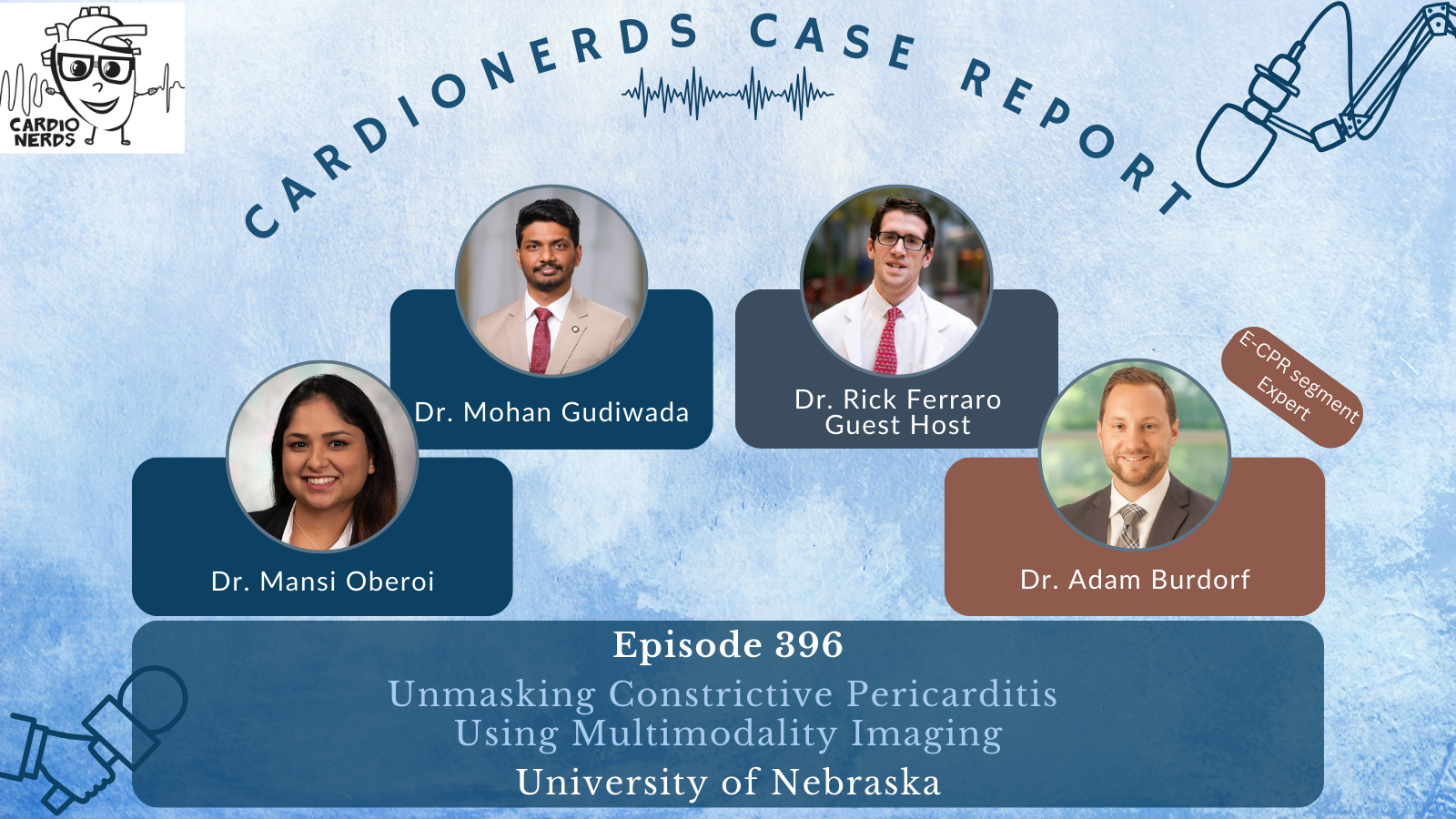
CardioNerds (Dr. Dan Ambinder and Dr. Rick Ferraro) join Dr. Mansi Oberoi and Dr. Mohan Gudiwada from the University of Nebraska Medical Center discuss a case of constrictive pericarditis. Expert commentary is provided by Dr. Adam Burdorf, who serves as the Program Director for the Cardiovascular Medicine Fellowship at the University of Nebraska Medical Center.
The case discussed involves a 76-year-old woman with a history of monoclonal gammopathy of undetermined significance, chronic obstructive pulmonary disease, type 2 diabetes mellitus, and squamous cell carcinoma was admitted to the hospital for worsening shortness of breath, swelling in lower extremities, hyponatremia, and urinary tract infection. CT chest to evaluate for pulmonary embolism showed incidental pericardial calcifications; the heart failure team was consulted for the management of her decompensated heart failure. Echo images were nondiagnostic. Subsequent invasive hemodynamic monitoring showed elevated right and left-sided filling pressures, diastolic equalization of LV and RV pressures, and positive RV square root sign with ventricular interdependence. Cardiac MRI showed septal flattening on deep inspiration and septal bounce, suggestive of interventricular dependence. After a heart team discussion and with shared-decision making the patient opted for medical management owing to her comorbidities and frailty.
American Heart Association’s Scientific Sessions 2024
- As heard in this episode, the American Heart Association’s Scientific Sessions 2024 is coming up November 16-18 in Chicago, Illinois at McCormick Place Convention Center. Come a day early for Pre-Sessions Symposia, Early Career content, QCOR programming and the International Symposium on November 15. It’s a special year you won’t want to miss for the premier event for advancements in cardiovascular science and medicine as AHA celebrates its 100th birthday. Registration is now open, secure your spot here!
- When registering, use code NERDS and if you’re among the first 20 to sign up, you’ll receive a free 1-year AHA Professional Membership!
“To study the phenomena of disease without books is to sail an uncharted sea, while to study books without patients is not to go to sea at all.” – Sir William Osler. CardioNerds thank the patients and their loved ones whose stories teach us the Art of Medicine and support our Mission to Democratize Cardiovascular Medicine.
US Cardiology Review is now the official journal of CardioNerds! Submit your manuscript here.
Case Media – Constrictive Pericarditis
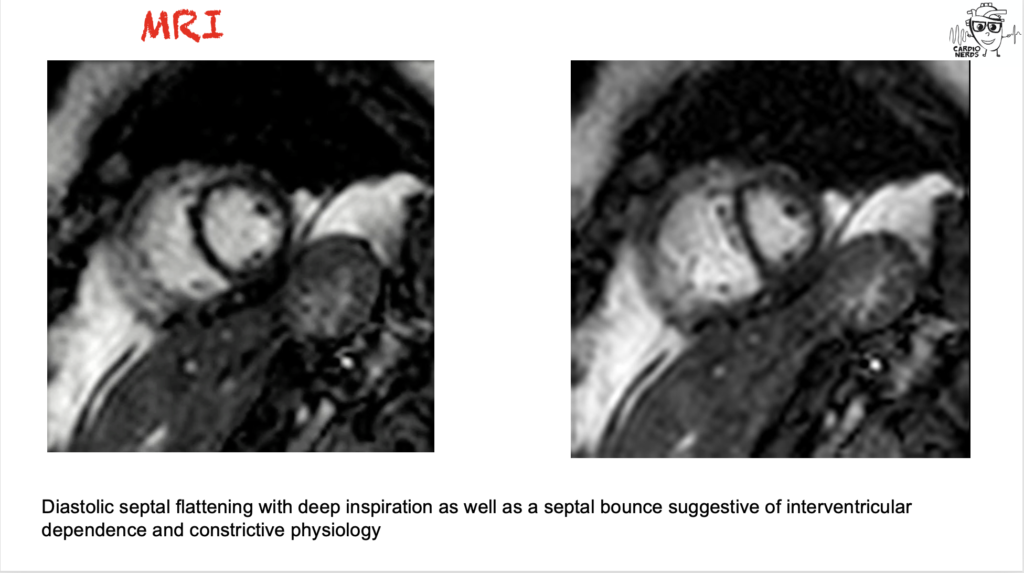
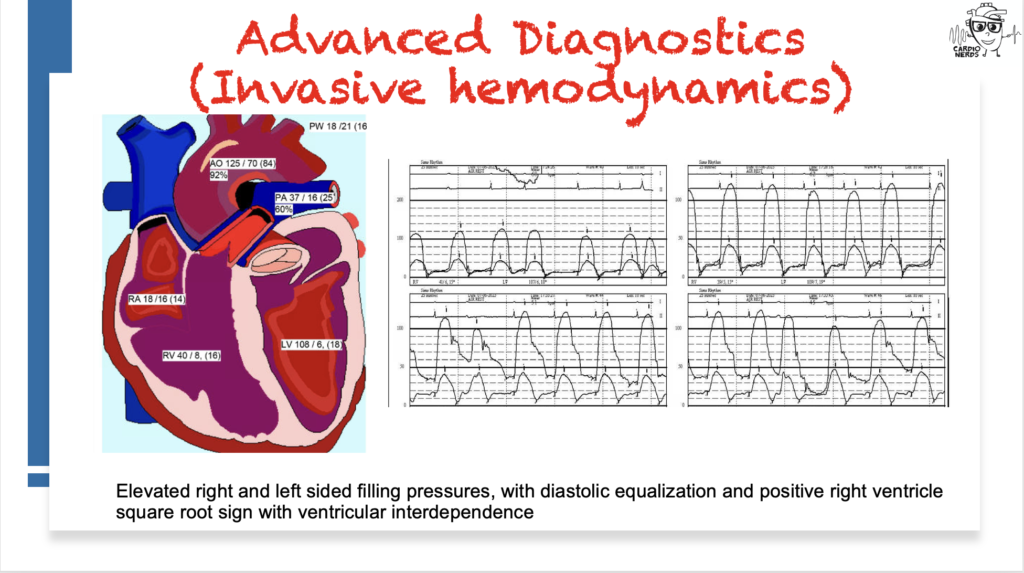
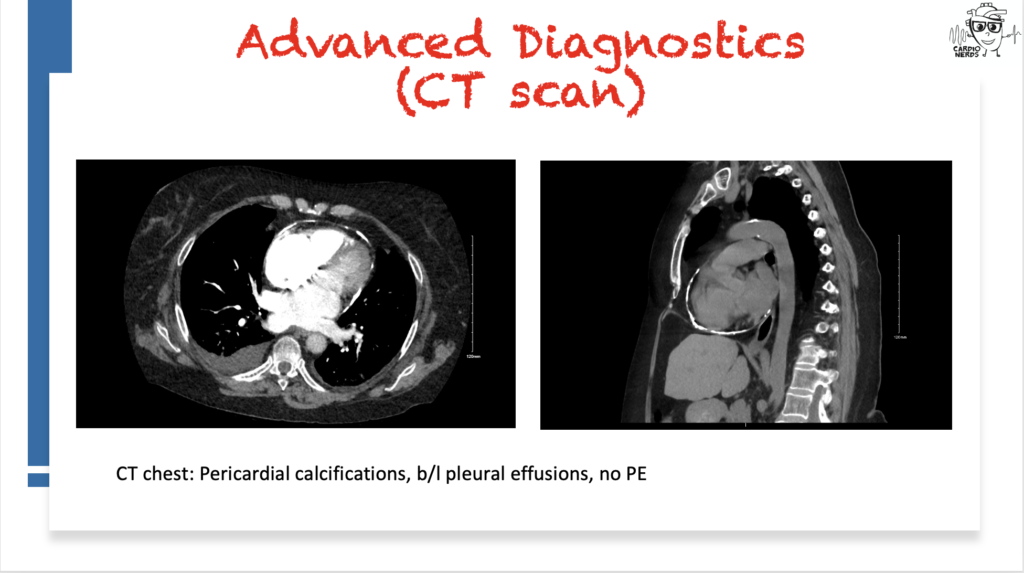
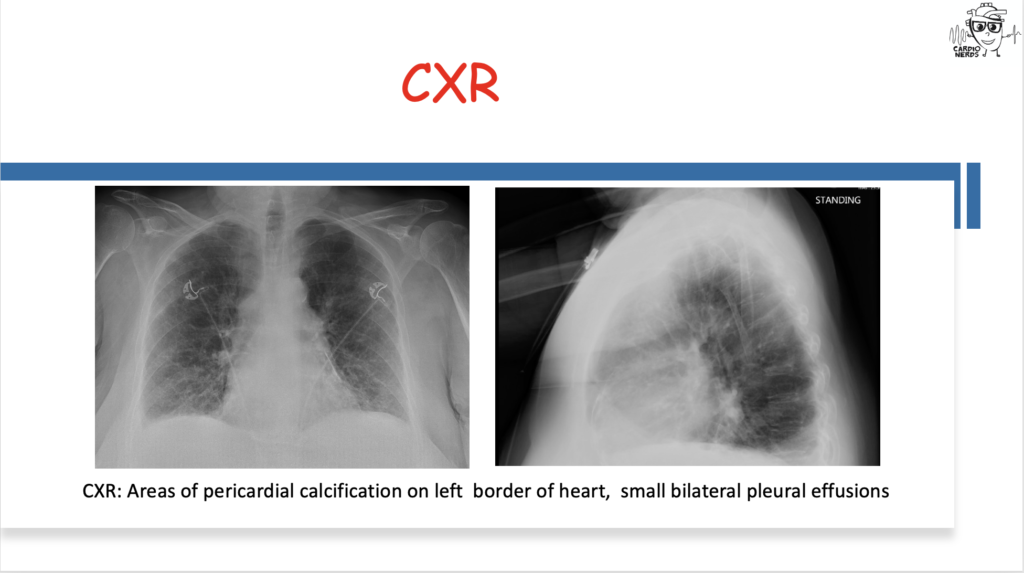
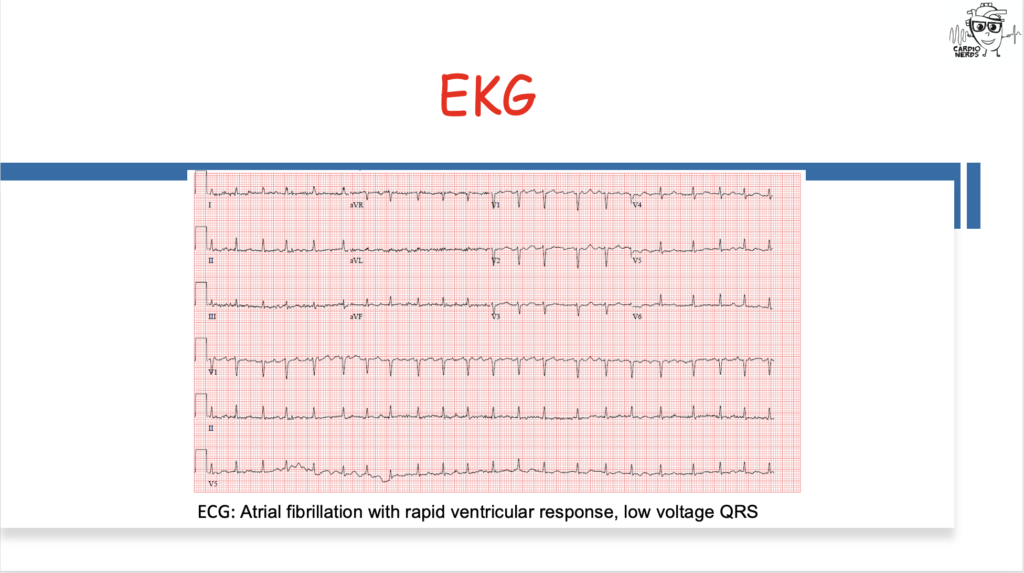
Echo: Left Ventricular ejection fraction = 55-60%. Unclear septal motion in the setting of atrial fibrillation
MRI: Diastolic septal flattening with deep inspiration as well as a septal bounce suggestive of interventricular dependence and constrictive physiology
References
- Garcia, M. Constrictive Pericarditis Versus Restrictive Cardiomyopathy. Journal of the American College of Cardiology, vol. 67, no. 17, 2016, pp. 2061–2076.
- Pathophysiology and Diagnosis of Constrictive Pericarditis. American College of Cardiology, 2017.
- Geske, J., Anavekar, N., Nishimura, R., et al. Differentiation of Constriction and Restriction: Complex Cardiovascular Hemodynamics. Journal of the American College of Cardiology, vol. 68, no. 21, 2016, pp. 2329–2347.
- Constrictive Pericarditis. ScienceDirect.
- Constrictive Pericarditis. Journal of the American College of Cardiology, vol. 83, no. 12, 2024, pp. 1500-1512.
408 episoder
Manage episode 446112053 series 2585945

CardioNerds (Dr. Dan Ambinder and Dr. Rick Ferraro) join Dr. Mansi Oberoi and Dr. Mohan Gudiwada from the University of Nebraska Medical Center discuss a case of constrictive pericarditis. Expert commentary is provided by Dr. Adam Burdorf, who serves as the Program Director for the Cardiovascular Medicine Fellowship at the University of Nebraska Medical Center.
The case discussed involves a 76-year-old woman with a history of monoclonal gammopathy of undetermined significance, chronic obstructive pulmonary disease, type 2 diabetes mellitus, and squamous cell carcinoma was admitted to the hospital for worsening shortness of breath, swelling in lower extremities, hyponatremia, and urinary tract infection. CT chest to evaluate for pulmonary embolism showed incidental pericardial calcifications; the heart failure team was consulted for the management of her decompensated heart failure. Echo images were nondiagnostic. Subsequent invasive hemodynamic monitoring showed elevated right and left-sided filling pressures, diastolic equalization of LV and RV pressures, and positive RV square root sign with ventricular interdependence. Cardiac MRI showed septal flattening on deep inspiration and septal bounce, suggestive of interventricular dependence. After a heart team discussion and with shared-decision making the patient opted for medical management owing to her comorbidities and frailty.
American Heart Association’s Scientific Sessions 2024
- As heard in this episode, the American Heart Association’s Scientific Sessions 2024 is coming up November 16-18 in Chicago, Illinois at McCormick Place Convention Center. Come a day early for Pre-Sessions Symposia, Early Career content, QCOR programming and the International Symposium on November 15. It’s a special year you won’t want to miss for the premier event for advancements in cardiovascular science and medicine as AHA celebrates its 100th birthday. Registration is now open, secure your spot here!
- When registering, use code NERDS and if you’re among the first 20 to sign up, you’ll receive a free 1-year AHA Professional Membership!
“To study the phenomena of disease without books is to sail an uncharted sea, while to study books without patients is not to go to sea at all.” – Sir William Osler. CardioNerds thank the patients and their loved ones whose stories teach us the Art of Medicine and support our Mission to Democratize Cardiovascular Medicine.
US Cardiology Review is now the official journal of CardioNerds! Submit your manuscript here.
Case Media – Constrictive Pericarditis





Echo: Left Ventricular ejection fraction = 55-60%. Unclear septal motion in the setting of atrial fibrillation
MRI: Diastolic septal flattening with deep inspiration as well as a septal bounce suggestive of interventricular dependence and constrictive physiology
References
- Garcia, M. Constrictive Pericarditis Versus Restrictive Cardiomyopathy. Journal of the American College of Cardiology, vol. 67, no. 17, 2016, pp. 2061–2076.
- Pathophysiology and Diagnosis of Constrictive Pericarditis. American College of Cardiology, 2017.
- Geske, J., Anavekar, N., Nishimura, R., et al. Differentiation of Constriction and Restriction: Complex Cardiovascular Hemodynamics. Journal of the American College of Cardiology, vol. 68, no. 21, 2016, pp. 2329–2347.
- Constrictive Pericarditis. ScienceDirect.
- Constrictive Pericarditis. Journal of the American College of Cardiology, vol. 83, no. 12, 2024, pp. 1500-1512.
408 episoder
Alle episoder
×Velkommen til Player FM!
Player FM is scanning the web for high-quality podcasts for you to enjoy right now. It's the best podcast app and works on Android, iPhone, and the web. Signup to sync subscriptions across devices.




